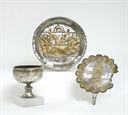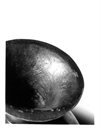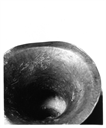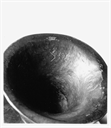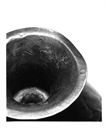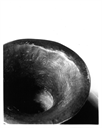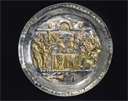Description
This paten, chalice, and fan (BZ.1924.5, BZ.1955.18, and BZ.1936.23, respectively) were said to have been found together at Riha, a small village south of Aleppo in central Syria. Their burial in this area was probably in response to invasions during the early seventh century by Sasanian and Arab forces and, because their owners had to flee or were killed, the silver objects were not retrieved until the early twentieth century. This group and silver treasures from nearby Stuma, Hama, and Antioch were discovered at about the same time, and it has been suggested that these individual hoards actually constituted one large group brought together for protective burial, which was divided into smaller sets after it was unearthed about one hundred years ago.
The chalice, paten, and fan are each impressed with stamps that indicate the emperor’s reign during which it was made. The chalice was fabricated during the reign of Justinian I (527–65), while the paten and fan belong to the reign of his successor, Justin II (565–78). Although the chalice’s date indicates that it was not made along with the paten and fan, the three may well have been used together at a subsequent date. They form a set for use in the Orthodox Eucharist, or Communion: the paten held the leavened bread, still a tradition in Orthodox worship, the chalice contained the wine, and the fan was used to keep insects away from the bread and the wine. Jesus instituted the Eucharist, as recorded in the gospels of Matthew (26:26–28) and Mark (14:22–24): offerings of bread and wine to the apostles that foreshadowed the sacrifice of Christ’s body and blood.
The distribution of wine was an integral part of the Eucharist, so that chalices were made in the same material as patens, often as a set (diskopoterion). This chalice, with its large bowl, small knob, and flaring foot, has the typical shape and proportions of many other sixth-century chalices. The bowl of the chalice allowed a large amount of wine to be held, evidence that Communion was distributed only on periodic occasions throughout the ecclesiastical year. A chalice of this shape and relative size is represented on the altar on the Riha paten.
The words of the niello inscription around the chalice would have been said by the priest celebrating Communion: “Thine own of Thine own we offer Thee, O Lord." These words also appeared on the altar of the imperial church of Hagia Sophia (Holy Wisdom) in Constantinople.
- S. Zwirn
Bibliography
W. F. Volbach, Metallarbeiten des christlichen Kultes in der Spätantike und im frühen Mittelalter, Kataloge des Römisch-Germanisches Central-Museums 9 (Mainz, 1921), 17.
M. Rosenberg, Der Goldschmiede Merkzeichen (Frankfurt am Main, 1922-1928) vol. 4, no. 9929-9936.
O. M. Dalton, East Christian Art, a Survey of the Monuments (Oxford, 1925), 329.
Exposition internationale d'art byzantin, exhibition catalogue, Musée des Arts Décoratifs, Palais du Louvre (Paris, 1931), no. 407.
H. Peirce and R. Tyler, L'Art Byzantin, vol. 2 (Paris, 1932-34), 124, pl. 170.
L. Bréhier, La Sculpture et les Arts Mineurs Byzantins (Paris, 1936), 85ff.
R. J. Gettens and C. L. Waring, "The Composition of Some Ancient Persian and Other Near Eastern Silver Objects," Ars Orientalis 2 (1957): 83-90.
Erica C. Dodd, Byzantine Silver Stamps (Washington, DC, 1961), 69, no. 8.
M. C. Ross, Catalogue of the Byzantine and Early Mediaeval Antiquities in the Dumbarton Oaks Collection, Vol. 1, Metalwork, Ceramics, Glass, Glyptics, Painting (Washington, D.C., 1962), 10-12, no. 9, pl. 10.
Handbook of the Byzantine Collection (Washington, D.C., 1967), 17, no. 60.
M. M. Mango, Silver from Early Byzantium: the Kaper Koraon and Related Treasures, exhibition catalogue, The Walters Art Gallery (Baltimore, 1986), no. 30.
A. Kirin, J. N. Carder, and R. S. Nelson, Sacred Art, Secular Context : Objects of Art from the Byzantine Collection of Dumbarton Oaks, Washington, D.C., Accompanied by American Paintings from the Collection of Mildred and Robert Woods Bliss, ed. A. Kirin, exhibition catalogue, Georgia Museum of Art (Athens, Ga., 2005), 38, 42.
G. Bühl, ed., Dumbarton Oaks: The Collections (Washington, D.C., 2008), 76-77, 80, pl. p. 81.
W. D. Ray, Tasting Heaven on Earth: Worship in Sixth-Century Constantinople, The Church at Worship: Case Studies from Christian History (Grand Rapids, Mich., 2012), 29.
H. Hunter-Crawley, "Embodying the Divine: The Sensational Experience of the Sixth-Century Eucharist," in Making Senses of the Past: Toward a Sensory Archaeology, Center for Archaeological Investigations Occasional Paper, ed. J. Day (Carbondale, IL, 2013), esp. 166, fig. 8-2.
M. Milwright, The Dome of the Rock and its Umayyad Mosaic Inscriptions, Edinburgh Studies in Islamic Art 6 6 vols., ed. R. Hillenbrand (Edinburgh, 2016), 191, no. 7.16.
Exhibition History
Paris, Musée des Arts Décoratifs, "Exposition internationale d'art byzantin," May 28 - July 9, 1931.
Baltimore, Walters Art Gallery, "Silver Treasure from Early Byzantium," April 18 - Aug. 17, 1986.
Los Angeles, J. Paul Getty Museum, "Holy Image, Hallowed Ground: Icons from Sinai," Nov. 14, 2006 - March 4, 2007.
Washington, DC, Dumbarton Oaks, "The Collector's Microbe: Mildred and Robert Woods Bliss and the Dumbarton Oaks Collections," April 9 - Nov. 9, 2008.
Washington, DC. Dumbarton Oaks, 75 Years/75 Objects: Celebrating 75 Years of the Dumbarton Oaks Museum, September 8, 2015 - May 22, 2016.
Münster, Germany, LWL-Museum für Kunst und Kultur, Frieden. Von der Antike bis heute (Peace. From Antiquity to the Present Day), April 27, 2018 - September 2, 2018.
